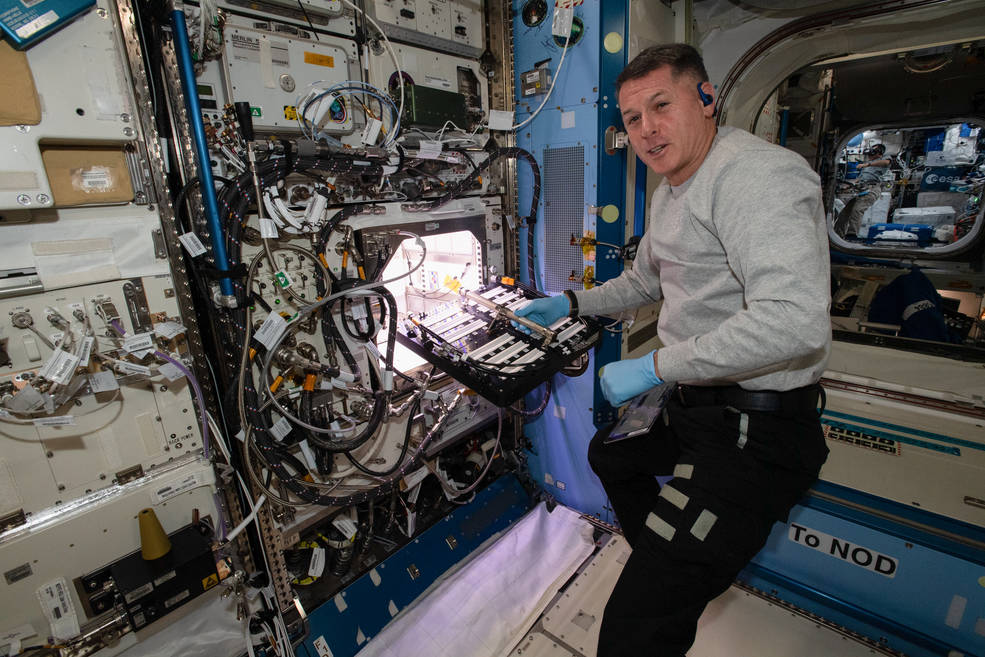Astronauts are growing chile peppers in space in spicy first
Space plants are entering a spicy realm as astronauts will soon get to sample chile peppers grown in orbit.
A batch of chile peppers seeds has been planted on the International Space Station as part of a new experiment that aims to expand the range of space-grown foods ahead of a possible future mission to Mars.
The 48 Hatch chile pepper seeds arrived at the orbital outpost June 5 with the SpaceX Dragon CRS-22 commercial resupply mission. Now, the red and green chile peppers are starting to grow as part of NASA's Plant Habitat-04 experiment, the agency said in a Tuesday (July 13) statement.
Astronauts get most of their fresh food supplies from cargo ships, but earlier versions of the Habitat experiment already produced some tasty treats. During the previous three harvests, crews have enjoyed space-grown red lettuce, Mizuna mustard and two other lettuce types, and radishes. Astronauts have also grown flowering plants, such as zinnias, to spruce up their living quarters.
Current Expedition 65 astronaut Shane Kimbrough, who got to sample space-grown outredgeous red romaine lettuce during his 2016 mission, himself initiated this version of the Habitat experiment. Unfortunately, Kimbrough will likely be back on Earth by the time the chile peppers are ready in four months, as he and other SpaceX Crew-2 astronauts are expected to splash down in October.
Related: Abundant harvest in Antarctic greenhouse shows promise for moon agriculture
Nevertheless, the experiment team with NASA Kennedy Space Center's exploration research and technology program paid tribute to the crew's efforts to continue developing space food as part of a larger research effort to feed astronauts on deep space missions. Once on the moon or Mars, astronauts will not be able to rely on supplies from Earth and will have to grow more food locally. That's where the Habitat research will fit in, its team stated.
"It is one of the most complex plant experiments on the station to date because of the long germination and growing times," Matt Romeyn, principal investigator for Plant Habitat-04, said in the NASA statement. "We have previously tested flowering to increase the chance for a successful harvest because astronauts will have to pollinate the peppers to grow fruit."
Breaking space news, the latest updates on rocket launches, skywatching events and more!
The experiment is hosted in the Advanced Plant Habitat, one of three plant chambers in which astronauts can grow and harvest food, flowers and other crops. Much of the maintenance work can be performed remotely by teams on the ground at Kennedy, reducing the hands-on time by busy astronauts in orbit.
Astronauts are known to get stuffy heads in microgravity, so spicy foods are often on the menu anyway to help encourage them to eat. This pepper variety, called the NuMex 'Española Improved' pepper (a hybrid Hatch pepper) naturally grows in zones such as New Mexico, NASA said. Researchers spent two years deciding among two dozen varieties before picking this one for a space ride, due to its potential for feeding astronauts on missions further away from Earth.
"We are limited to crops that don't need storage, or extensive processing," Romeyn said. All peppers also have the advantage of being dense in Vitamin C and other nutrients, providing good nutrition along with taste. Additionally, the colorful red – which will pop up late in the growing cycle – may benefit the astronauts' mental health, based on past studies suggesting bright vegetables are a boon, Romeyn added.
The crew will sample some of the 48 peppers (that number assumes all the seeds planted make it to maturity), and send the rest back to Earth for further analysis. The science team will evaluate the flavor and texture of the peppers from crew feedback, along with Scoville measurements, which evaluates the plants' "heat" or spiciness. That, the researchers said, can depend in part on the environment in which it was grown, so changing how much water, light and heat the plants get might actually affect how hot they will be.
"The combination of microgravity, light quality, temperature, and rootzone moisture will all affect flavor, so it will be interesting to find out how the fruit will grow, ripen, and taste," LaShelle Spencer, Plant Habitat-04's project science team lead, said in the same NASA statement.
"The food astronauts eat needs to be as good as the rest of their equipment," Spencer added. "To successfully send people to Mars and bring them back to Earth, we will not only require the most nutritious foods, but the best-tasting ones as well."
Follow Elizabeth Howell on Twitter @howellspace. Follow us on Twitter @Spacedotcom and on Facebook.

Elizabeth Howell (she/her), Ph.D., was a staff writer in the spaceflight channel between 2022 and 2024 specializing in Canadian space news. She was contributing writer for Space.com for 10 years from 2012 to 2024. Elizabeth's reporting includes multiple exclusives with the White House, leading world coverage about a lost-and-found space tomato on the International Space Station, witnessing five human spaceflight launches on two continents, flying parabolic, working inside a spacesuit, and participating in a simulated Mars mission. Her latest book, "Why Am I Taller?" (ECW Press, 2022) is co-written with astronaut Dave Williams.

